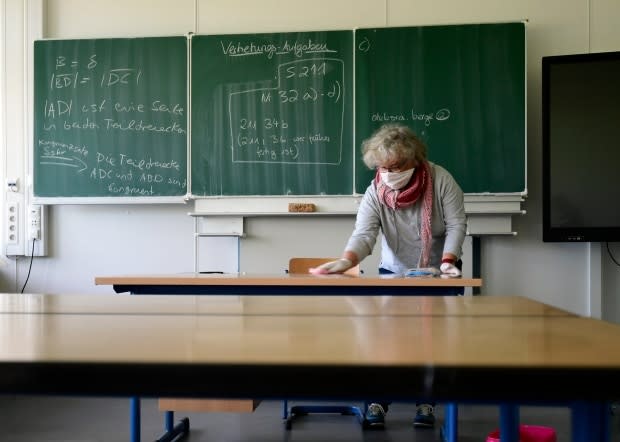What works to flatten the curve and what science says on easing restrictions

Public health interventions like physical distancing, closing schools and prohibiting large gatherings have been effective in flattening the curve in many countries, according to a new Canadian study that could guide the lifting of restrictions.
The researchers emphasize that lifting lockdowns must happen gradually, rather than all at once.
"We need to be very careful here," said Dr. Peter Juni, a professor of epidemiology and medicine at the University of Toronto, and the study's lead author. "Otherwise we will have mass gatherings on school yards and in gyms et cetera, which could backfire big time."
The study, which appears in this week's issue of the Canadian Medical Association Journal, found that putting two restrictions in place at once — such as closing schools and asking people to physically distance themselves — reduced the growth of new COVID-19 cases by at least 30 per cent.

The study also shed light on what role climate may play in the epidemic's growth. The researchers found no association between local temperature or latitude and the spread of COVID-19.
"Unfortunately for all of us, the weather won't come to our help too much here," Juni said.
It's possible, however, that humidity played a minor role in hindering the growth of new cases. But it paled in comparison to the effects of distancing and preventing mass gatherings, the researchers said.
No need to fear fellow citizens
Ray Deonandan, an associate professor and epidemiologist at the University of Ottawa, who was not involved in the study, called it good news that public health measures like distancing, school closures, limiting access to businesses and banning mass gatherings were effective.
Deonandan said "throwing open the doors" isn't safe or scientific, and doesn't offer flexibility to make adjustments as needed. Epidemics across Canada are unfolding differently and public health measures should reflect how populations' tolerance of restrictions or easing them differ from province to province.
"We shouldn't be afraid of our fellow citizens," he said. "The caseload is now low enough that we can start to venture into the territory of opening up economies at the same time not be so confident to be flagrant with our hygiene discipline."
For the study researchers at the University of Toronto, Western University in London, Ont., and colleagues in Switzerland compared how well 144 countries performed in flattening their epidemic curves. States and provinces in Australia, the United States and Canada were all involved in the research.
The study is based on the number of cases each place had in early March, when the lockdowns began, compared with the number of cases they had on March 27.
That incubation period reflected how long the virus can take to cause symptoms.
WATCH | Practical tips for physical distancing:
China, where the outbreak was contained when the data was collected, was excluded from the analysis. South Korea and Iran were not included because their epidemics were further along.
Answers on hand
Deonandan said the findings also point to opportunities to get creative and combine measures for safety, such as offering childcare to smaller groups of young children than daycares did before the pandemic.
"The banning of mass gatherings seems a no-brainer," he said, adding people should consider keeping large concerts, sporting events and maybe even large dinner parties off the table for a while.
Prof. Paul Hunter from the University of East Anglia's medical school and his U.K.-based team came to many similar conclusions about the effectiveness of bans on mass gatherings and closing non-essential businesses, particularly in the hospitality sector, and closing schools across Europe. Their draft study has not been peer reviewed for key feedback on potential errors and weaknesses.
Dr. Yves Longtin, an infectious disease specialist and chair of infection prevention and control at Montreal's Jewish General Hospital, he said he's delighted that research is coming out so quickly.
The findings are important given how some questioned whether distancing and other measures were warranted to slow the spread of the pandemic months ago.
"It's very exciting to see that there is research being conducted and we finally have answers to questions that we had such as which measures are the most effective."


